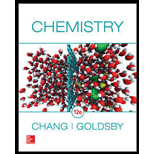
Concept explainers
Interpretation:
The longest wavelength associated with the Lyman series, the shortest wavelength associated with the Balmer series (in nanometers) and verification for not overlapping the spectral lines of the Lyman and Balmer series should be explained using the concept of Bohr’s theory.
Concept Introduction:
The emission of radiation given by an energized hydrogen atom to the electron falling from a higher-energy orbit to a lower orbit give a quantum of energy in the form of light. Based on electrostatic interaction and law of motion, Bohr derived the following equation.
Where,
The electrons are excited thermally when the light is used by an object. As a result, an emission spectrum comes. Line spectra consist of light only at specific, discrete wavelengths. In emission, the electron returns to a lower energy state from
This transition results in the photon’s emission with frequency
When
To find: The longest wavelength associated with the Lyman series, the shortest wavelength associated with the Balmer series (in nanometers) and verification for not overlapping the spectral lines of the Lyman and Balmer series
Answer to Problem 7.109QP
The longest wavelength associated with the Lyman series is
Explanation of Solution
The energy difference (
Therefore, the energy difference (
Planck’s constant,
Therefore, the longest wavelength associated with the Lyman series is
Therefore, the energy difference (
Planck’s constant,
Therefore, the shortest wavelength associated with the Balmer series is
The longest wavelength associated with the Lyman series, the shortest wavelength associated with the Balmer series (in nanometers) and verification for not overlapping the spectral lines of the Lyman and Balmer series are explained using the concept of Bohr’s theory.
Want to see more full solutions like this?
Chapter 7 Solutions
Chemistry
- Can I get helpp drawing my arrowsarrow_forwardWhich of the m/z values corresponds to the base peak in the mass spectrum shown? 100 80 A. 45 B. 44 C. 29 D. 15 Intensity 20 0 10 20 30 40 B- m/z -8 50 E. 30 Which of the m/z values correspond to the molecular ion for the compound shown? A. 18 B. 82 OH C. 100 D. 102 E. 103arrow_forwardCan someone help me with drawing my arrows.arrow_forward
- I'm having trouble with converting lewis diagrams into VSEPR diagrams. I currently have this example of C2BrCl3 which I want to turn into a lewis structure, but I'm not sure what steps I need to do in order to do so. I have the table written down, however, there's two central atoms so what would I do? There seems to be 4 electron domains on the carbon atom and no lone pairs so it would seem like this shape would be tetrahedral. Here's what I have now. Thanks!arrow_forwardWe discussed the solid phase resin using in peptide synthesis. Provide a mechanism, for its formation. DRAW THE MECHANISM.arrow_forwardPlease help. Every time I've asked an expert in the past, it's been wrong :(arrow_forward
 General Chemistry - Standalone book (MindTap Cour...ChemistryISBN:9781305580343Author:Steven D. Gammon, Ebbing, Darrell Ebbing, Steven D., Darrell; Gammon, Darrell Ebbing; Steven D. Gammon, Darrell D.; Gammon, Ebbing; Steven D. Gammon; DarrellPublisher:Cengage Learning
General Chemistry - Standalone book (MindTap Cour...ChemistryISBN:9781305580343Author:Steven D. Gammon, Ebbing, Darrell Ebbing, Steven D., Darrell; Gammon, Darrell Ebbing; Steven D. Gammon, Darrell D.; Gammon, Ebbing; Steven D. Gammon; DarrellPublisher:Cengage Learning Chemistry: Principles and PracticeChemistryISBN:9780534420123Author:Daniel L. Reger, Scott R. Goode, David W. Ball, Edward MercerPublisher:Cengage Learning
Chemistry: Principles and PracticeChemistryISBN:9780534420123Author:Daniel L. Reger, Scott R. Goode, David W. Ball, Edward MercerPublisher:Cengage Learning Chemistry for Engineering StudentsChemistryISBN:9781337398909Author:Lawrence S. Brown, Tom HolmePublisher:Cengage Learning
Chemistry for Engineering StudentsChemistryISBN:9781337398909Author:Lawrence S. Brown, Tom HolmePublisher:Cengage Learning- Chemistry: Matter and ChangeChemistryISBN:9780078746376Author:Dinah Zike, Laurel Dingrando, Nicholas Hainen, Cheryl WistromPublisher:Glencoe/McGraw-Hill School Pub Co
 Chemistry: The Molecular ScienceChemistryISBN:9781285199047Author:John W. Moore, Conrad L. StanitskiPublisher:Cengage Learning
Chemistry: The Molecular ScienceChemistryISBN:9781285199047Author:John W. Moore, Conrad L. StanitskiPublisher:Cengage Learning Chemistry & Chemical ReactivityChemistryISBN:9781133949640Author:John C. Kotz, Paul M. Treichel, John Townsend, David TreichelPublisher:Cengage Learning
Chemistry & Chemical ReactivityChemistryISBN:9781133949640Author:John C. Kotz, Paul M. Treichel, John Townsend, David TreichelPublisher:Cengage Learning





